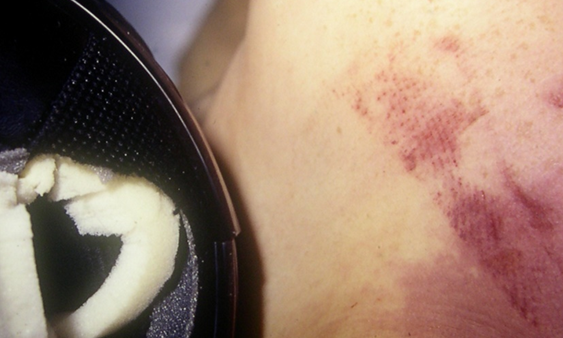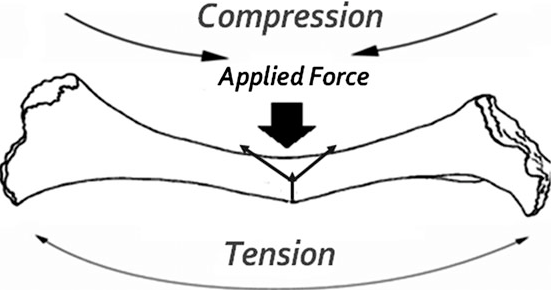Dr Andrew describes various types of blunt force injury and gives Medico-legal examples.
Blunt impact injuries is a commonly used term on death certificates when the fatality is due to extensive physical trauma such as seen in vehicular crashes, falls from height or beatings. The term “blunt force injuries” is also commonly seen but is a bit of a misnomer in that force has magnitude and direction, but it is neither blunt nor sharp. This brings to mind the need for precise use of the nomenclature to assure proper interpretation of mechanism of injury. Cases which may be subject to litigation months or even years after the fact will depend on accurate documentation for reliable interpretation.
Blunt impact injuries are of four basic classes:
- Contusion – on application of force, tissue is crushed, subcutaneous blood vessels are disrupted, but skin is intact.
- Abrasion – compressive and/or tangential force scrapes and partially removes the superficial layers of epidermis.
- Laceration – applied force shears or tears skin.
- Fracture of bone
Contusions are manifested by hemorrhage into skin and/or subcutaneous tissue. In certain circumstances, critical observation may permit reconstruction of the circumstances of injury. A specific pattern may suggest a class of or even specific object. The distribution may speak to inflicted vs. accidental trauma. Unlike abrasions, contusions are often larger than the area of actual impact due to their fluid nature. In fact, seepage can occasionally give a false impression of separate impact sites, for example neck hemorrhage in jaw fractures and thigh hemorrhage in pelvic fractures.
Attempting to date contusions based on their gross appearance or using images is fraught with error. Bruises of many colors may be seen as a result of a single traumatic episode.
Variables include the quantity of hemorrhage, effectiveness of local circulation, age, drugs that inhibit clotting such as aspirin and “blood thinners,” liver disease, the anatomic area bruised and others. The microscope can provide much more reliable information for dating contusions.
Medico-legal relevance: A pediatric expert testified that contusions observed at autopsy of a deceased toddler were all sustained approximately 12 hours before death based on photographic images. Microscopical examination clearly establishes a range of injury times from hours to up to three days.
Abrasions or scrapes can be accentuated by drying. Close examination of loose tissue fragments and tags may indicate the direction of force. Patterns are not uncommon and may define the nature of the applied force, for example coarse fabrics or textured objects.
Medico-legal relevance: In dispute because of varying witness accounts was whether or not the operator of a motorcycle was wearing a helmet at the time of a fatal collision. The patterned abrasion at the base of the rear of the neck of the deceased recapitulated the fabric pattern of the internal helmet padding, confirming it was being worn at the time of the crash.
Lacerations, a term frequently misapplied by clinicians in describing incised wounds and other cutting injuries, are true tears of stressed skin. Soft tissue bridging, typically seen in depths of or at corners of lacerations is a key feature. These filamentous bridges are comprised of nerves, blood vessel, elastic and collagen fibers which are not as easily torn as skin. The more tangential the impact, the more likely it will cause avulsion, or tearing of large flaps of skin. The plasticity or potential mobility of tissues influences the occurrence of lacerations. Other factors include skin over bony prominences and, for internal organs, fixation by ligaments (aorta, liver) or being on a pedicle (kidney, spleen).
As blunt impact injuries, lacerations generally have irregular margins with or without abraded or contused edges. Abraded edges may correspond to shape and dimension of impacting object. Patterns may be suggestive, especially in head trauma. Symmetry and undermining may establish the direction of force.
Medico-legal relevance: A laceration of the liver in a toddler who died under suspicious circumstances was attributed to an abusive kick to the abdomen. The presence of the laceration immediately adjacent to the falciform ligament, tethering the liver to the diaphragm and its relatively bloodless appearance is more consistent with this being a resuscitation-related injury and not abuse.
Fractures of bone, come in a wide variety of patterns that may suggest a specific mechanism. Different types of bone fracture differently, for example skull, versus flat bones versus long, tubular bones. Some fractures are nearly unique to their mechanism, for example the “Colle’s fracture” caused by a fall on an outstretched hand, fracture of the calcaneus bone due to landing on the feet from a fall from height, fractures of the sacroiliac joints due to falls directly on the buttocks and “boxer’s fractures” of the metacarpal bones.
Medico-legal relevance: The driver in an unwitnessed collision with a pedestrian claims she walked in front of his vehicle and was facing him when she was struck. Multiple external injuries made corroboration of this difficult. An expert for the plaintiff in a civil case opined she had been struck from behind. Examination of the fracture patterns of both legs proved the driver was truthful.
Image from “Interpreting Injury Mechanisms of Blunt Force Trauma from Butterfly Fracture Formation” – Samantha L Reber, T. Simmons, Published 2015, Journal of Forensic Sciences



